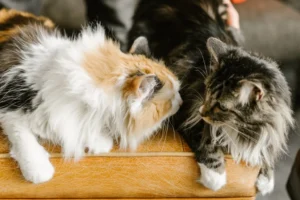Cats seem to have a magical ability to squeeze into the tiniest of spaces, leaving many pet owners scratching their heads in wonder. But why can cats fit anywhere? Let’s explore the fascinating reasons behind this curious feline behavior.
Cats’ Flexible Bodies:
Flexible Skeletal Structure
Have you ever marveled at how cats can squeeze themselves into the tightest spaces? It all comes down to their flexible skeletal structure. Unlike humans, cats have free-floating collarbones, which allows them to rotate their shoulders in almost any direction. Combine this with highly flexible vertebrae, and you have a recipe for a contortionist extraordinaire.
Cats can twist and turn their bodies in ways that seem almost supernatural, thanks to their unique bone structure. Their ability to arch their backs and fit through narrow openings is a result of this exceptional flexibility. So next time you see your feline friend contorting into a seemingly impossible position, remember, it’s all in their bones.
Limber Joints
When it comes to agility and flexibility, cats take the cake. One of the key reasons behind their impressive maneuverability is their limber joints. These well-oiled joints allow cats to twist and turn with ease, navigating through narrow gaps effortlessly.
Cats’ joints are designed to provide a wide range of motion, allowing them to bend and stretch in ways that would make a gymnast jealous. This incredible flexibility is essential for their survival in the wild, enabling them to escape predators and hunt with precision. So, the next time you see your cat effortlessly squeezing into a tiny box, you’ll know it’s all thanks to their remarkable joints.
Cats’ Innate Instincts: – Cats have a natural instinct to seek out small, enclosed spaces for safety and security. In the wild, these tight spaces offer protection from predators and a cozy spot to rest undisturbed. – When cats curl up in a box or wedge themselves into a narrow gap, they are instinctively mimicking their behavior in the wild. These snug spots provide comfort and a sense of security, tapping into their primal instincts. So, don’t be surprised when your cat pops up in the most unexpected places—they’re just following their instincts.
Predatory Nature
Cats are masters of fitting into tight spaces, and their natural hunting instincts play a huge role in this behavior. In the wild, small, enclosed spaces provide cats with a sense of safety and security, allowing them to observe their surroundings without being seen. This instinct is deeply ingrained in them, driving them to seek out similar spaces in your home. So, don’t be surprised if your furry friend squeezes into a tiny box or curls up in a closet – it’s just their predatory nature at work.
Territorial Behavior
When it comes to finding the purr-fect hiding spots, cats are all about establishing their territory. They have a strong need for ownership and a sense of security, which leads them to seek out cozy nooks and crannies in your home. By claiming these spaces as their own, cats feel more secure and in control of their environment. So, if you find your cat tucked away in a tight spot, know that they’re just asserting their territorial behavior and making themselves feel right at home.
Cats’ Evolutionary Adaptations: – Flexible Bodies: Cats have a unique skeletal structure that allows them to contort their bodies and squeeze into tight spaces with ease. – Whiskers: Their whiskers are not just cute accessories; they help cats gauge whether they can fit through a space before attempting to do so. – Sharp Claws: Cats’ sharp claws enable them to grip onto surfaces and maneuver themselves into even the smallest openings. – Agility: Cats are incredibly agile creatures, thanks to their powerful muscles and exceptional balance, making it easier for them to navigate through cramped spaces.
Remember, when your cat decides to disappear into a seemingly impossible spot, it’s all thanks to their remarkable evolutionary adaptations that have been finely tuned over centuries. So, embrace their inner daredevil and marvel at their natural abilities to fit anywhere they please.
Survival in the Wild
Cats’ ability to fit into small spaces is an evolutionary trait dating back to their wild ancestors. In the wild, cats used tight spots to hide from predators, giving them a survival advantage. This behavior has been passed down through generations, explaining why your domesticated feline friend can squeeze into seemingly impossible places in your home.
Efficient Energy Conservation
Burrowing into snug spaces is not just about hiding; it also helps cats conserve body heat. This trait is particularly important for wild cats living in diverse environments, where staying warm can be a challenge. By curling up in small, cozy places, cats reduce their exposed surface area, conserving energy that would otherwise be spent on keeping warm. So, next time you see your cat curling up in a tight space, know that it’s not just seeking comfort—it’s also a clever energy-saving strategy.
Interesting Facts About Cats: – Purring Power: Cats purr not only when they’re happy but also when they’re anxious or in pain. It’s believed that purring can have a soothing effect on their bodies. – Superior Senses: Cats have incredible hearing abilities, which is why they can detect high-frequency sounds that are outside the range of human hearing. – Whisker Wonders: A cat’s whiskers are not just for show; they are highly sensitive tactile hairs that help cats navigate and sense their surroundings, even in the dark. – Acrobatic Artists: Cats are known for their impressive agility and flexibility, thanks to their unique skeletal structure and powerful muscles. – Mysterious Meows: Unlike dogs, cats have a wide range of vocalizations. Each cat’s meow is distinct, tailored to communicate specific needs or desires. So, pay attention to your cat’s meows—it could be trying to tell you something important!
Remember, the next time you marvel at your cat’s ability to fit into the tiniest nooks and crannies, you’re witnessing a skill honed over generations for survival and efficiency.
Cat’s Preferable Sleeping Spots
Cats are notorious for squeezing themselves into seemingly impossible nooks and crannies for a little shut-eye. Whether it’s a snug cardboard box, a warm spot on top of the fridge, or a freshly laundered pile of clothes, these furry felines have a knack for finding the perfect nap spot. One reason cats love confined spaces is their instinctual need for security. Tight spaces provide a sense of safety and protection, allowing them to relax and unwind without feeling vulnerable. Additionally, cats are natural hunters, and small, enclosed spaces mimic the cozy, hidden spots where they would stalk their prey in the wild. So, the next time you find your cat nestled in a tight space, remember that it’s not just about being cute – it’s also about feeling safe and secure.
- Under the bed: Cats find the space under the bed comforting due to the enclosed feeling and protection it offers.
- Inside bags or boxes: The texture and smell of these items mimic surfaces cats would naturally gravitate towards, like bushes or hiding spots in the wild.
- On high perches: Cats love to perch up high to survey their surroundings and feel in control of their environment.
- In warm laundry baskets: The warmth of freshly washed clothes is inviting and reminds cats of snuggling up with their littermates for a nap.
Mysterious Cat Behavior
Cats are enigmatic creatures, and their behavior in tight spaces only adds to their mystique. One peculiar behavior you may notice is their tendency to contort their bodies in unusual ways when exploring confined areas. Cats are incredibly flexible animals, with a spine that allows for a wide range of motion. This flexibility enables them to squeeze into tight spaces with ease, showcasing their agility and grace. Another intriguing behavior is the way cats seem to meticulously investigate every nook and cranny, even in the most cramped of spaces. This curiosity is a natural trait that stems from their innate hunting instincts, as they explore their surroundings with keen perception and attention to detail. So, the next time you catch your cat cramming themselves into a tiny corner, know that it’s all part of their mysterious charm.
Remember to provide plenty of hiding spots and cozy spaces for your cat to explore and relax in. This can help alleviate stress and anxiety, allowing your feline friend to feel safe and secure in their environment.
Alex, a passionate animal lover, has experience in training and understanding animal behavior. As a proud pet parent to two dogs and three cats, he founded AnimalReport.net to share insights from animal experts and expand his knowledge of the animal kingdom.









